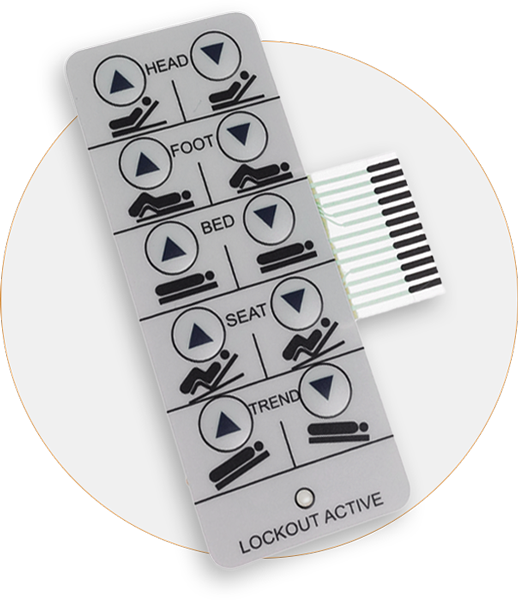The Full Guide to Membrane Switch Innovation and Its Applications
The Full Guide to Membrane Switch Innovation and Its Applications
Blog Article
Exactly How Membrane Layer Changes Add To the Toughness of Electronic Control Panels
Membrane buttons play a vital duty in enhancing the resilience of electronic control panels, largely via their multi-layered construction which offers efficient protection versus environmental aspects such as moisture and dust. The lack of relocating parts significantly lowers the chance of mechanical failures, making membrane switches over perfect for requiring applications.
Meaning of Membrane Layer Switches

Membrane switches are developed to be slim and light-weight, making them ideal for applications where space is restricted. They can be produced in various forms, sizes, and colors, providing adaptability in layout that satisfies visual and practical needs. Additionally, membrane layer buttons can incorporate various innovations, such as responsive feedback and LED indicators, improving customer experience.
Due to their building and construction, membrane layer buttons are usually resistant to dirt, wetness, and general wear, adding to their durability in requiring atmospheres. Their seamless layout not only promotes easy cleaning however also minimizes the risk of mechanical failing, making them a favored option for producers seeking dependable user interfaces in their electronic control panels.
Defense Versus Environmental Variables
The style of membrane layer switches over inherently gives a degree of security against numerous environmental factors, which is vital for maintaining capability in challenging problems - Membrane Switch. These buttons are commonly created with layers of flexible materials that shield internal parts from moisture, dust, and impurities. By encapsulating the circuitry, membrane switches decrease the threat of short circuits and rust, which can substantially hinder efficiency
Moreover, making use of robust adhesives and sealers during production improves their resistance to ecological challenges. Membrane switches can sustain direct exposure to chemicals and solvents, making them suitable for markets such as food handling and medical care, where hygiene and cleanliness are critical. Their seamless surface layout additionally protects against the buildup of dirt and germs, assisting in simpler cleaning and maintenance.
Temperature variations are another environmental worry, and membrane switches are engineered to operate effectively across a large range of temperature levels (Membrane Switch). This adaptability ensures that control panels continue to be operational in numerous settings, from commercial environments to consumer electronic devices
Impact on Customer Communication
Customer communication with digital control panels is considerably affected by the design and performance of membrane layer switches. These buttons supply a responsive user interface that improves the general individual experience, permitting instinctive navigating and control. Their responsive nature makes sure that individuals get prompt comments upon activation, which is vital for tasks requiring precision use this link and effectiveness.
Additionally, the smooth surface of membrane layer switches over assists in easy cleaning and upkeep, advertising customer confidence in the dependability of the user interface. This sanitation is particularly important in settings where health is paramount, such as clinical or food processing settings. In addition, the portable and lightweight layout of membrane layer switches adds to the visual charm of control panels, motivating customer interaction with a contemporary and streamlined appearance.
Moreover, the combination of visual elements, such as printed icons and backlighting, aids users rapidly recognize features, decreasing the discovering curve linked with new equipment. Therefore, individuals can operate tools extra properly, bring about boosted productivity and complete satisfaction. In recap, membrane switches play a pivotal function in boosting individual communication by integrating capability, appearances, and ease of use, ultimately resulting in enhanced functional performance.
Style Adaptability and Customization
Style flexibility and personalization are crucial facets of membrane buttons, enabling producers to customize electronic control panels to certain applications and customer requirements. This adaptability allows for the assimilation of numerous design aspects, such as colors, graphics, and structures, which can boost the aesthetic charm and individual involvement of the control board.
Membrane switches can be customized in shapes and size, accommodating a large range of devices and applications, from industrial machinery to customer electronic devices. This versatility makes certain that makers can produce instinctive interfaces that straighten with user assumptions and operational requirements. In addition, the ability to incorporate special attributes such as backlighting or tactile responses additionally improves use, enabling a much more interactive experience.
Additionally, the production procedure for Membrane Switch membrane layer changes sustains the fast prototyping of styles, enabling makers to repeat and fine-tune their concepts quickly. This capacity not just increases the advancement timeline however additionally ensures that the end product satisfies details useful and visual criteria.

Cost-Effectiveness and Longevity
Cost-effectiveness and longevity are significant advantages of membrane layer switches, making them an appealing choice for producers and end-users alike. Discover More Here These buttons are usually less costly to produce than standard mechanical switches, largely because of their simplified production processes and the decreased variety of parts needed. This price benefit extends not only to initial production however also to lasting operational expenses, as membrane layer switches usually need less maintenance and have a reduced failing rate.
Moreover, the longevity of membrane layer switches over contributes to their total worth. Built from resilient materials, they are resistant to ecological factors such as wetness, dirt, and chemicals, which can lead to premature wear in other switch kinds. The lack of moving components lessens mechanical failure, enabling membrane switches to keep capability over prolonged durations.
This sturdiness is specifically useful in applications calling for consistent efficiency under demanding conditions, such as clinical devices and commercial equipment. Inevitably, the combination of cost-effectiveness and longevity makes membrane changes a financially viable choice for producers, offering reliable options that hold up against the test of time while maximizing budgetary considerations.
Final Thought
In final thought, membrane buttons dramatically enhance the toughness of electronic control panels via their durable building and construction and safety features - Membrane Switch. Overall, membrane layer switches represent a dependable and cost-effective choice for improving the long life and performance of digital control systems.
Report this page